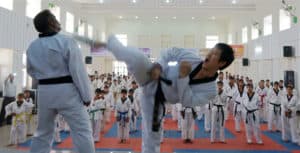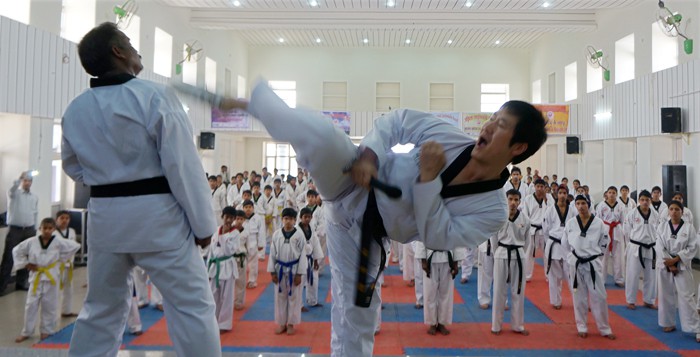 The sparring gear I was wearing made my body feel twenty times hotter than the dojang that I was sparring in. I was fighting a guy who was slightly older than me in terms of age, but light years ahead of me in terms of skill. I wasn’t just sweating because of the heat; adrenaline was pumping through my veins, my mind was in high alert, and sparring is nothing like doing drills. With drills, you are kicking pads or punching into the air at your reflection in the mirror or at some phantom opponent in your mind. In sparring, you are simulating a real fight, with a real person, who can really hurt you, which is simultaneously exciting and nerve-wracking.
The sparring gear I was wearing made my body feel twenty times hotter than the dojang that I was sparring in. I was fighting a guy who was slightly older than me in terms of age, but light years ahead of me in terms of skill. I wasn’t just sweating because of the heat; adrenaline was pumping through my veins, my mind was in high alert, and sparring is nothing like doing drills. With drills, you are kicking pads or punching into the air at your reflection in the mirror or at some phantom opponent in your mind. In sparring, you are simulating a real fight, with a real person, who can really hurt you, which is simultaneously exciting and nerve-wracking.
I remember trying to get in a few roundhouse kicks to his chest, and at one point even tried to land a crescent kick to his head, but he was FAST, and was using the best weapons in his arsenal to combat me: his mind and his experience. It seems as if he could read my every move before I even made it. I kept trying to land blows, but it was to no avail, until I saw an opening! I had dodged one of his back kicks, which I thought was a mistake on his part, which left his back exposed for a moment so I went in with a front kick to land a blow.
But it was not a mistake on his part, I was being setup.
I went in for the kick, and saw him fling himself around quickly, then felt a quick, hard impact to my head. After that, my world went fuzzy. My headgear, which was tightly fastened to my head, went sideways across my face. My arms, which should always be in the “fighting position” during sparring, went straight down to my sides. I stared blankly in front of me in a daze and everything went out of focus. He had landed a roundhouse kick straight to my head. I think the only reason I didn’t fall over and hit the mat was because my Taekwondo instructor, who was facilitating the fight, had told him not to land another blow.
Ah, the joys of martial arts. Roundhouse kicks to the head aside, learning taekwondo was a great experience, and learning ABOUT taekwondo was an equally enlightening experience. Through taekwondo I was exposed to the Korean language, food, history and culture. I also eventually got better at not getting kicked in the head! Here at the library, we have plenty of books and e-books that can teach you how to be a better practitioner of the arts, and can also deepen and enrich your understanding of what makes each martial art unique.
Taekwondo is an art that originated in Korea, and was formally established shortly after World War II, but has even deeper roots in older arts like Japanese karate and numerous Chinese and Korean martial arts. It was introduced here in America by Jhoon Rhee, the “Father of American Taekwondo” in the late 1950s who opened his first martial arts studio in Washington, D.C. in 1962. Tae kwon do’s literal interpretation is “tae” which translates to stomp or trample, “kwon” which translates to fist, and “do” which translates to “way.” The book The Secrets of Tae Kwon Do: Principles and Techniques for Beginners, by Jennifer Lawler is a great resource for learning about the history, philosophy, forms, and techniques of taekwondo. All martial arts are about combat at their core, and most have roots in some form of intense military training, but, as Lawler states in her book, “The ultimate goal of Taekwondo training is the development of qualities that make you a better person. All Taekwondo students are expected to learn and follow the Five Tenets of Taekwondo” which are:
- Courtesy
- Integrity
- Perseverance
- Self-Control
- Indomitable Spirit
These tenets, along with the theme of personal betterment, are the reason many people pursue martial arts in general. As Lawler states, “Part of the process of living the way of taekwondo is to appreciate how to use the tenets not just in the training hall but in everyday life.” Martial arts is not just about training to defend yourself, it’s about reaching your highest potential and learning inner skills that can be used in all areas of your life.
I used to enjoy watching kids practice their drills and spar before my afternoon class would start. Unlike us adults, kids do not put in a full day at work before class, and are not as worried about getting hurt or being sore the next day. They just give it 110%! We have some great resources in our Children’s department for your little warriors. Taekwondo! by Terry Pierce is a Step into Reading book that will teach your little ones the fundamentals of reading and inspire them in their training. For the slightly older reader, we have Taekwondo, by Tim O’Shei which is a nice introduction to the history of taekwondo as both an art, and as a sport. As always, our Hoopla app is brimming with books for both kids and adults about taekwondo’s history and style.
Of course, taekwondo is just the tip of the iceberg. There are countless martial arts from all corners of the world for you to learn, and learn about. Each has their own unique history, distinct style, culture and philosophy. Here at the Morrill Memorial Library, we have all the resources you need to improve your fighting skills and hone the greatest weapon in your arsenal: your mind.
Check out some of these other great reads to learn more.
Tae Kwon Do: the Ultimate Reference Guide to the World’s Most Popular Martial Art, by Yeon Hee Park
Tae Kwon Do the Indomitable Martial Art of Korea: Basics, Techniques and Forms, by Dong Keun Park & Allan Schein
Tae Kwon Do: the Korean Martial Art, by Richard Chun
Brian DeFelice is the Information Technology Librarian at the Morrill Memorial Library in Norwood, MA. Look for his article in the March 14, 2019 issue of the Norwood Transcript.


